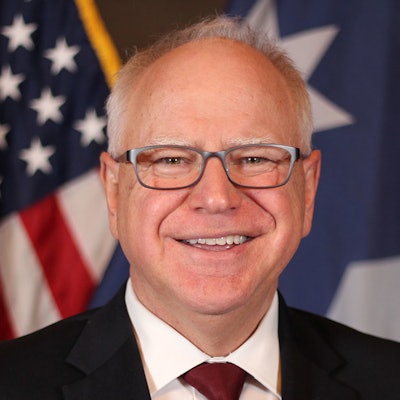 Tim Walz
Tim Walz
Walz has served as governor of Minnesota since 2019, following a 12-year stint in Congress as a Minnesota representative.
During his time in the House, Walz sponsored or co-sponsored a handful of trucking-related bills. Those include:
Allowing VA physicians to perform DOT physicals: Walz co-sponsored the Veterans’ Expanded Trucking Opportunities Act, which was introduced in October 2015 and was included as an amendment to the 2015 FAST Act transportation funding bill. It allowed qualified Department of Veterans Affairs physicians to sign up to be on the Federal Motor Carrier Safety Administration’s National Registry of Certified Medical Examiners (NRCME) to perform DOT physicals for military veterans. After the bill’s inclusion in the FAST Act, FMCSA published a final rule in 2018 allowing VA physicians to be listed on the NRCME.
[Related: VA medical examiners land easier path to National Registry]
Repealing the Federal Excise Tax (FET) on trucks: Walz co-sponsored an attempt in 2017 to repeal the 12% FET on the sale of new heavy trucks and trailers. That effort never made it past the committee level, and attempts to repeal the FET are still ongoing today. He also co-sponsored a concurrent resolution in 2015 advocating against increasing the FET that also never made it past committee.
[Related: FET repeal may hinge on truck safety, high ZEV cost and supply chain issues]
Sleep apnea screening: Walz was a co-sponsor on a bill that became law in 2013 that required a formal rulemaking process for any authorization by the DOT to implement or enforce a requirement providing for the screening, testing, or treatment of individuals operating commercial motor vehicles for sleep disorders (including obstructive sleep apnea). The law barred FMCSA from using guidance alone to address sleep apnea screening for drivers. It also didn’t require FMCSA to make a sleep apnea screening rulemaking. It did, however, require that if the agency did take action on sleep apnea screening, it do so via the formal rulemaking process rather than guidance. FMCSA began that process in 2016, but the rule was later withdrawn in 2017.
[Related: Sleep apnea bill becomes law, FMCSA can’t use guidance to address driver screening]
Vision Zero Act: In 2015, he co-sponsored the Vision Zero Act, which would have created a grants program within the DOT for a city, town, township, borough, county, parish, district, village, or other political subdivision of a state to develop a Vision Zero plan to eliminate transportation-related fatalities and serious injuries in its jurisdiction. This bill did not make it past committee.
MAP-21: Walz was also among 122 co-sponsors of the 2012 MAP-21 highway appropriations bill that became law, which included a number of trucking-related provisions, from what would become FMCSA’s electronic logging device mandate to provisions to increase brokers’ bond requirement from $10,000 to a minimum $75,000.
As governor, Walz and the Minnesota Department of Transportation in January announced $17.4 million for eight construction projects in the Twin Cities Metro and Greater Minnesota to improve transportation infrastructure, funding that came from the state’s competitive Transportation Economic Development (TED) and Transportation Economic Development Infrastructure (TEDI) programs. Also in January, the U.S. Department of Transportation awarded more than $1 billion funding to replace the John A. Blatnik Bridge between the ports of Duluth and Superior, Wisconsin – an important freight and commercial connection between the cities that serve more than 33,000 vehicles per day, according to a statement issued by Walz’s office.
Under Walz as governor, Minnesota has also adopted the California Air Resources Board’s Low-Emission Vehicle and Zero-Emission Vehicle regulations, which apply to passenger vehicles, but the state has yet to adopt CARB’s Advanced Clean Trucks standard.
[Related: Where Trump’s VP pick J.D. Vance stands on speed limiters, brokering fraud, parking]